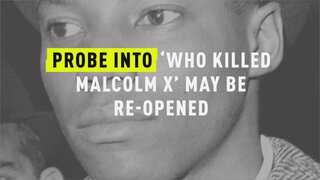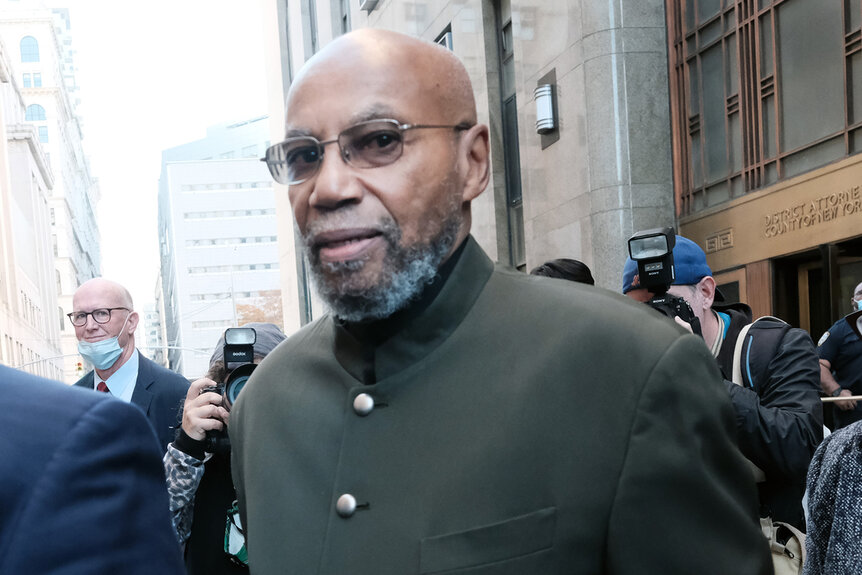Create a free profile to get unlimited access to exclusive videos, breaking news, sweepstakes, and more!
Man Exonerated In Malcolm X Assassination To Sue New York City, State
Muhammad Aziz and Khalil Islam were wrongfully convicted in 1966 of playing roles in the assassination. Now Aziz and Islam's estate have announced plans to sue.

One of two men now deemed wrongfully convicted in the 1965 assassination of civil rights leader Malcolm X has a claim against the state of New York and filed a notice of claim against New York City.
Lawyers for Muhammad A. Aziz (who was convicted under his name at the time, Norman 3X Butler), 83, announced Tuesday that they plan to seek compensation under the state's New York's Unjust Conviction and Imprisonment Act, which allows people wrongfully convicted of crimes to recover damages from the state.
"The more than 20 years that I spent in prison were stolen from me and my family," Aziz — who was released in 1985 — said in a statement. "And while the official record now recognizes the truth that has been known for decades, nothing can undo the damage that my wrongful conviction caused to all of us."
"Those responsible for depriving me of my liberty and for depriving my family of a husband, a father, and a grandfather should be held accountable," he added.
The statement from Aziz's lawyers says that a similar claim from the estate of Khalil Islam — who was released in 1987 and died in 2009 at age 74 — is expected soon.
In addition, Aziz's lawyers filed a "notice of claim" against New York City, naming 86 officers and employees of the New York City Police Department and 100 "John/Jane Doe" employees. A notice of claim is required to filed a lawsuit against the city.
In it, they state that their claims will include: "false arrest and imprisonment; malicious prosecution; abuse of process; violations of civil rights under 42 U.S.C. § 1983 (including violations of the Fourth, Fifth, Sixth, and Fourteenth Amendments to the United States Constitution); fraud; negligent misrepresentation; negligence (including, but not limited to negligent supervision, including failure to adequately discipline; negligent training; and negligent hiring and retention); respondeat superior; intentional infliction of emotional distress; negligent infliction of emotional distress; and prima facie tort."
"Respondeat superior" is the legal doctrine that holds employers responsible for the actions of their employees if the acts are part of the scope of their employment.
Aziz's lawyers state in the notice that officers engaged in "false statements and testimony, suppression of evidence of Mr. Aziz’s innocence, fabrication of evidence, subornation of perjury, and abuse of process." They plan to ask for $40 million as well as additional fees and expenses.
Aziz, Islam and a third man who ultimately confessed to his role, Mujahid Abdul Halim (then known as Talmadge "Thomas Hagan" Hayer), 81, were arrested shortly after the assassination in 1965. But only Halim, who was shot during the attack by one of Malcolm X's bodyguards, was captured at the site of the murder; he denied at trial and in multiple interviews throughout the 1970s and '80s that either Aziz or Islam had been involved.
Aziz and Islam had been part of the Nation of Islam's Harlem mosque, where Malcolm X had preached and with which he had split at the time of his murder. Multiple people told author and historian Manning Marable that Malcolm X's people had barred anyone from the Harlem mosque — including Aziz and Islam — from the ballroom at which he was speaking when he was killed.
Aziz also had multiple alibi witnesses that he was at home resting an injured foot; the doctor who treated him for the injury at Jacobi Hospital the night before the assassination testified for his defense. The most recent investigation by the Manhattan district attorney, which resulted in the men's exoneration, turned up yet another alibi witness who could place Aziz at his home — which was not close to the Audubon Ballroom in Washington Heights, where Malcolm X was killed — at the time of the assassination.
Islam was also at home, suffering from rheumatoid arthritis that left him hardly able to walk, according to an interview he gave to New York Magazine before his death.
Still, all three men were convicted of the killing and sentenced to life in prison.
Halim ultimately named his actual alleged accomplices in sworn affidavits to the court when Aziz and Islam's lawyer attempted to reopen their case in the late 1970s; that lawyer failed to persuade a judge to clear either man in 1978 and neither of Halim's alleged accomplices was reportedly investigated at that time.
Halim was released in in 2010 — almost more than two decades after either Aziz or Islam.
The recent investigation done by the Manhattan district attorney that resulted in the exoneration showed that the FBI had an informant at the time who named another man, known in 1965 as William Bradley, as part of the conspiracy, but they didn't share that information with prosecutors or the NYPD.
Bradley also matched the original description of the other shooter provided by a witness to the defense — and he matched the description of one of the shooters Halim named in 1978.
Bradley changed his name to Al-Mustafa Shabazz after the assassination. He was first identified publicly by historian Manning Marable's 2011 biography, "Malcolm X: A Life of Reinvention," but denied being involved in the assassination at the time. Bradley died in 2018.























